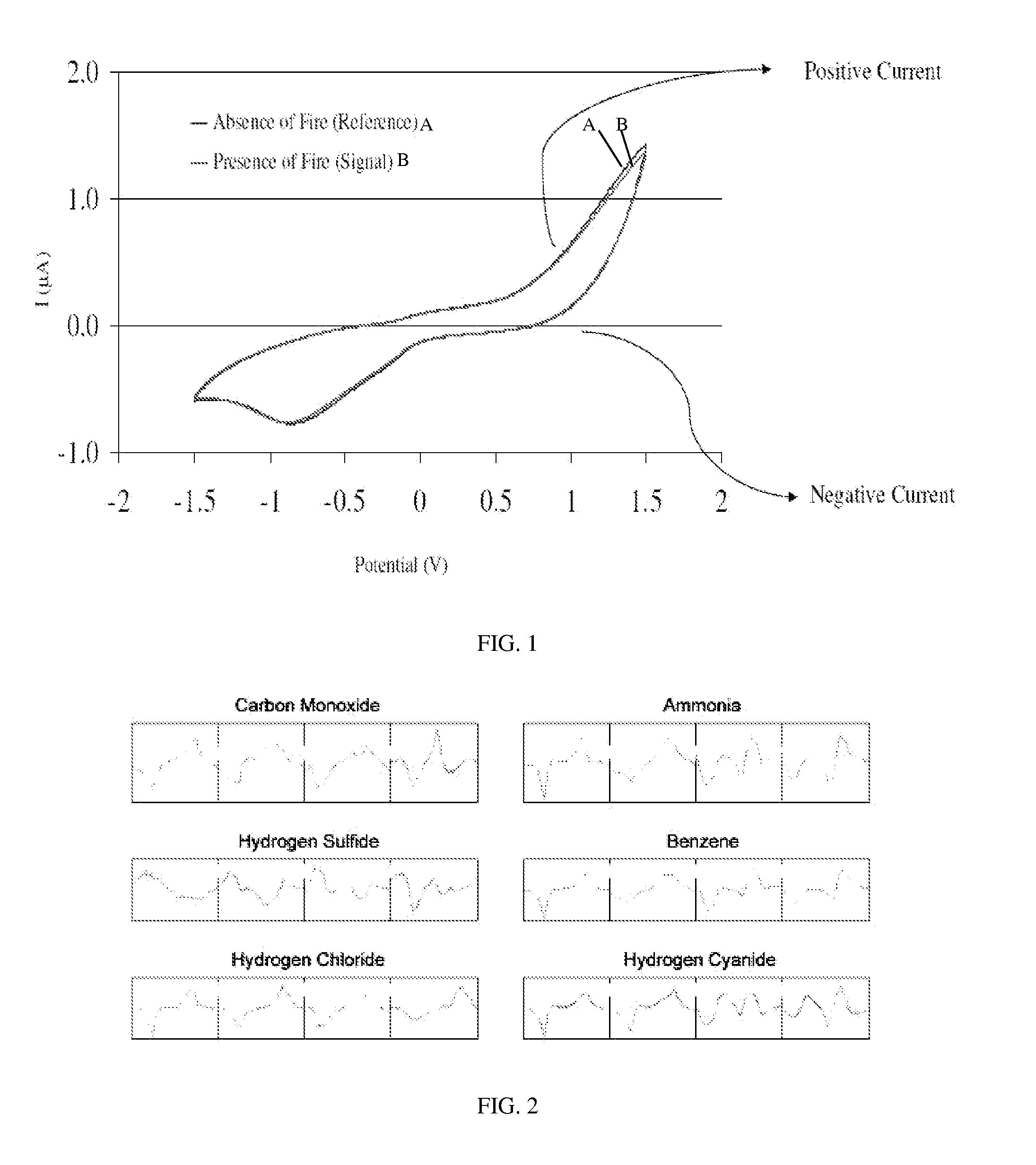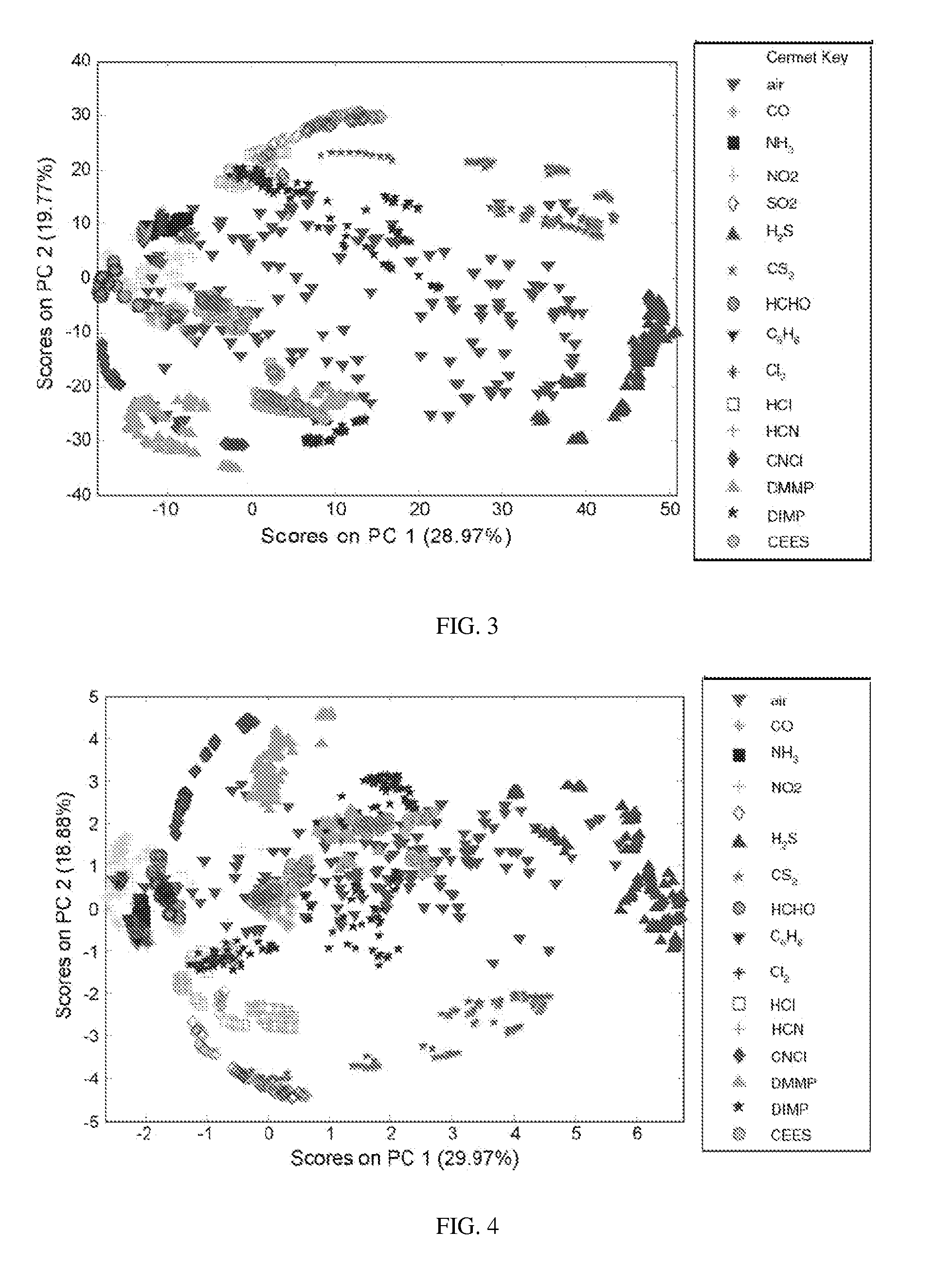Method and system for analyzing signal-vector data for pattern recognition from first order sensors
a signal-vector data and pattern recognition technology, applied in pulse manipulation, pulse technique, instruments, etc., can solve the problems of limited selection of multiple criteria electrochemical sensors, inability to discriminate fire-like nuisance sources using multiple criteria, and the inability of most sensors to have the specificity desired, etc., to optimize the performance of classifiers, maximize correct classification, and enhance feature selection
- Summary
- Abstract
- Description
- Claims
- Application Information
AI Technical Summary
Benefits of technology
Problems solved by technology
Method used
Image
Examples
examples 1 and 2
below utilize an array of four conventional cermet sensors which have different electrode-electrolyte-electrode configurations to provide slightly different sensing criteria. For example, in Example 1, sensor A is platinum-yttria stabilized zirconia-platinum / palladium (Pt—YSZ—Pt / Pd), sensor B is platinum-yttria stabilized zirconia-platinum (Pt—YSZ—Pt), sensor C is platinum-yttria stabilized zirconia-platinum-tungsten bismuth oxide (Pt—YSZ—Pt—WBO), and sensor D is platinum-yttria stabilized zirconia-platinum / palladium-tungsten bismuth oxide (Pt—YSZ—Pt / Pd—WBO). However, one skilled in the art can appreciate that data from only one sensor or from any plurality of sensors may be analyzed according to the present invention. Further, any data exhibiting such a cyclic waveform under various conditions should be suitable for analysis according to the present invention.
The following examples further describe the system and method of the present invention. In each Example, there generally exi...
example 1
Analyte Sensing for Detection of Particular Chemicals
In this example, the four sensors are exposed to clean air and then to a variety of analytes of interest. Analyte streams were produced by diluting certified gas cylinders of carbon monoxide (CO), nitrogen dioxide (NO2), sulfur dioxide (SO2), hydrogen sulfide (H2S), chlorine (Cl2), hydrogen chloride (HCl) (Air Gas, Los Angeles, Calif.) ammonia (NH3), carbon disulfide (CS2), benzene (C6H6), formaldehyde (HCHO), hydrogen cyanide (HCN) (Tex-La Gas, Sulphur, La.), and cyanogen chloride (CNCl) (HP Gas Products, Baytown, Tex.). Analyte streams of the nerve agent simulants dimethyl methylphosphonate (DMMP), diisopropyl methylphosphonate (DIMP), and 2-chloroethyl ethyl sulfide (CEES) were generated by certified permeation tubes (KIN-TEK, La Marque, Tex.). Various controllers were used such that the flow, temperature, and humidity of the purified air and analyte / air streams to create the known concentration of analyte needed under these kn...
example 2
Sensing for Fire Detection Under Different Conditions
Instead of sensing analytes for the detection of particular chemicals, cermet sensors were also used to detect fire or pre-cursors of a fire under various conditions using the data analysis methods of the previous invention as demonstrated by Example 1.
In both laboratory and shipboard environments, fire and nuisance sources were created to expose the detection systems to a range of potential shipboard scenarios. For example, the following fire sources were used in this example either in the laboratory environment, in the shipboard environment or in both environments: flaming cardboard box (with and without polystyrene pellets therein), flaming trash can, flaming shipping supplies, flaming mattress and bedding, flaming IPA spill, flaming heptane pan, flaming diesel-soaked rags, smoldering bag of trash, smoldering mattress and bedding, smoldering cable bundle, smoldering laundry, smoldering oily rags, heated painted bulkhead, IPA pa...
PUM
 Login to View More
Login to View More Abstract
Description
Claims
Application Information
 Login to View More
Login to View More - R&D
- Intellectual Property
- Life Sciences
- Materials
- Tech Scout
- Unparalleled Data Quality
- Higher Quality Content
- 60% Fewer Hallucinations
Browse by: Latest US Patents, China's latest patents, Technical Efficacy Thesaurus, Application Domain, Technology Topic, Popular Technical Reports.
© 2025 PatSnap. All rights reserved.Legal|Privacy policy|Modern Slavery Act Transparency Statement|Sitemap|About US| Contact US: help@patsnap.com



